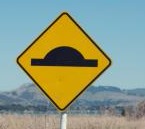Although the traffic laws and most signage are the same as in the US, driving in Mexico can challenge even the most experienced drivers. There have been many times I've stomped the floor with my imaginary brake pedal as a passenger, and "white knuckled" it as the driver.
One of the biggest challenges you'll face driving in Peñasco is the signage, or lack thereof. Most signs look the same as in the US. Well, usually. The red octagon stop sign can be very faded, so it may not be as noticeable. Or the sign got removed and there's only a pole remaining. Or the word "ALTO" (STOP--think HALT) is just painted on a telephone pole. Missing any of these could put you in danger of an accident or getting stopped by the police. Your best defense is slowing down as you approach intersections and looking at the opposite corner. If they have a stop sign, you do too, even if it's not actually there. Don't be fooled into complacency when you see locally-plated cars do a rolling stop. "Murphy's Law" is that your US plated car will get a ticket.
Another VERY important sign to be aware of is the "tope" yellow caution sign, also seen as "Reductor de Velocidad". Topes (pronounced TOE-peh) are speed bumps that can range from small 2-inch high bumps to get you to slow down before an intersection to large mountainous bumps that can ruin your suspension if you hit them too quickly. Just like stop signs, tope signs are not always still there, or were never well marked in the first place. There are three of them on the Sandy Beach road, with varying degrees of signage. Between the topes, railroad crossings, and potholes, there is a thriving business for tire repair shops (Llanteras) that you'll see all over town.

There are some non-symbol signs and customs that you also need to be aware of. For instance, if the local car in front of you on the highway puts on his left-turn signal, it may mean one of a few things: he is turning left, he is telling you it's okay to pass, or he simply forgot to turn it off. Don't assume it's safe unless he moves toward the shoulder, as a double indication for you to pass. ATV's are permitted on the streets and desert (but not most beaches), and people are permitted to ride in the back of pickup trucks. Give them extra space.
One last tip is to limit your driving at night. There are stray dogs roaming around the city streets, and coyotes and wildlife that cross the highways in search of food when the air cools after sundown. Though there are many road and lighting improvements happening, it's not the same as the US. There are lots of blind spots, unmarked curves and topes, medians that aren't quite where you'd expect them to be, and a severe lack of reflective tape /signage. Always be a defensive (and sober) driver. Driving under the influence is punishable and heavily enforced. Please don't ruin your vacation with an accident or visit to a Mexican jail. Taxis are plentiful and cheap in the big picture.
Stay safe and enjoy our fabulous little town!
Caution--PRECAUCION
Danger--PELIGRO and Dangerous--PELIGROSA and Dangerous Curve -- CURVA PELIGROSA
Dead End--CALLE SIN SALIDA
Don't Throw Trash (Don't Litter)--NO TIRE BASURA
If You Drink, Don't Drive--SI TOMA NO MANEJE
Keep Your Distance (Don't Tailgate)--CONSERVE SU DISTANCIA
Passing Prohibited / No Passing Zone--PROHIBIDO EL PASO or NO REBASE CON RAYA CONTINUA (No Passing on a Solid Line)
Pedestrian Crossing--CRUCE DE PEATON
Rest Area--ÁREA DE DESCANSO
Seat Belt Use Required--USO OBLIGATORIO CINTURON DE SEGURIDAD
Speed Bumps--REDUCTOR DE VELOCIDAD or TOPE
Slow--DESPACIO and Reduce Your Speed (Slow Down)--DISMINUYA SU VELOCIDAD
Wash Area (Dips in the road that are prone to flooding)-- ZONA DE VADOS
Yield-- CEDA and Yield the Way to Pedestrians--CEDA EL PASO AL PEATÓN


















